Sound Pressure Levels in Churches in Port Harcourt: A Study of Some Catholic, Anglican and Pentecostal Churches
OB da Lilly-Tariah, Chibuike Nwosu*, Victor O Ikenga, and Okechi C Mbalaso
Department of ENT Surgery, University of Port Harcourt Teaching Hospital, Nigeria
Submission: July 08, 2017; Published: July 28, 2017
*Corresponding author: Chibuike Nwosu, Department of ENT Surgery, University of Port Harcourt Teaching Hospital, Port Harcourt, Rivers State, Nigeria, Tel: 234 8038856760; Email: chibuikebgt@yahoo.com
How to cite this article: O d Lilly-Tariah, Chibuike N, Victor O I, Okechi C M. Sound Pressure Levels in Churches in Port Harcourt: A Study of Some Catholic, Anglican and Pentecostal Churches. Glob J Oto 2017; 9(2): 555758. DOI: 10.19080/GJO.2017.09.555758
Abstract
Churches represent an excellent environment in the propagation of sound which poses a high risk in the occurrence of noise induced hearing loss. According to the Nigerian National environmental standard and regulation Act 2007, the maximum permissible noise level in worship centers should not exceed 75dB and considering Nigeria to have the highest rate of church proliferation in the world makes it imperative to do this study. The aim of this study is to determine the level of sound exposure to church worshippers in Port Harcourt.
Methodology: A prospective, cross sectional study involving 30 churches (10 selected from catholic, Anglican and Pentecostal churches), selected by simple random sampling from Port Harcourt metropolis carried out between January to June 2015. Sound pressure level meter was used to measure the sound levels in churches. Data was collected and analyzed using SPSS 20.
Results: Thirty (30) churches participated in the study. The duration of service/mass was between 2-7 hours with a mean of 3.03 hours. The average SPL measurement was highest in Pentecostal churches (98.4 ± 3.1dB), followed by catholic churches (96.3 ± 6.8 dB), and the least Anglican churches (87.6 ± 1.3 dB). All the catholic churches, 50 % of Anglican and 60 % of Pentecostal churches were purpose built, but none was acoustically designed.
Conclusion: The SPLs reported in the churches are higher than the safety permissible limits of sound, thus making it unacceptable, illegal and punishable. There should be increased advocacy and implementation of the noise regulation laws in Nigeria in order to reduce the risk of noise induced hearing loss.
Keywords: Sound pressure level; Churches; Port Harcourt
Introduction
Excessive noise is increasingly encountered in many aspects of our daily life and it remains a problem in all regions of the world [1]. World health organization estimates that about 1.1 billion young people worldwide could be at risk of hearing loss and other deleterious effect due to unsafe listening practices [1].
Chronic exposure to moderate sound levels (< 90dB) as found in most church environment causes the hair cells especially the outer hair cells of the inner ear to degenerate within the 0rgan of Corti during each period of exposure [2]. Safe permissible sound levels to hearing, depend on the intensity (loudness) and duration of exposure [3,4]. The longer the exposure and the more intense the sound, the more the degeneration and loss of the hair cells [3]. These two factors are interrelated and contribute to the overall sound energy level to which the individual is exposed [3-5]. Effectively, the total amount of sound energy to which an individual can safely be exposed remains constant: the sound energy of lower volumes listened to over long periods of time is the same as that louder sounds heard for over a short period [6]. Permissible levels of daily exposure to noise have been defined on this basis, taking into account the daily permissible dose of sound; they have been calculated for occupational settings and are extrapolated for application in recreational settings [6,7]. The normal healthy ambient noise level is put at 50-60dB [8]. The highest safe exposure level is considered to be 85 dB for up to a maximum of 8 hours [6]. The permissible time for safe listening decreases as sound levels increase. Thus, the safe duration of exposure to a sound level of 100 dB is only 15 minutes a day. This is as shown in the Table 1 below [6,7].
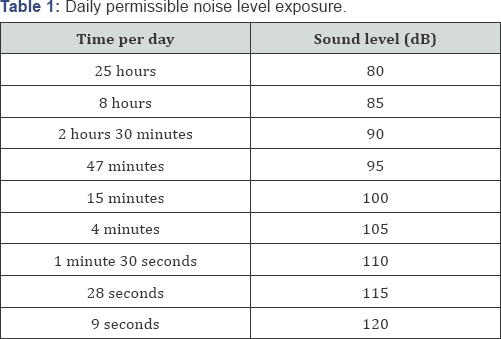
The global society today is undergoing significant constant proliferation of religious houses which are thought to provide solutions to the numerous problems confronting people, especially, the black race and Nigeria in particular [9]. Nigeria is a country with the highest number of churches per capital in the world and a fertile soil for the growth of independent churches [10]. This proliferation of religious houses is borne out of the understanding that in Nigeria, there is freedom of religious worship but central to this is the question of its environmental effects on the people in the society [9]. Religious houses are springing up at an alarming rate in all available spaces, shops, uncompleted buildings, warehouses, hotels, abandoned cinema buildings, studios and other public places. It is a common sight to see a minimum of fifty different religious centers on a street of four kilometers long [10].
Churches and places of worship represent an excellent sound propagation in a closed space which poses a high risk in the occurrence of noise induced hearing loss [11]. They have several sources of sound which includes piano, organs, bands, choir and the loud speakers [12]. The hazardous effect of sound in places of worship can be reduced by attaching "special sound limiters” to the sound systems [12]. These are devices that automatically limit the output volume or the intensity of sound produced from the systems, thereby reducing the resultant sound effect [13]. Very few churches in our environment have these devices and so the detrimental effects of sound are ensued. Additionally, during the planning of church buildings, acoustics should be considered which takes into account of echoes and reflections that strongly interferes with the effects of sound [12]. Sounds generated from sources can undergo both early and late reflections in a closed space [12]. This makes our listening and understanding to be very vulnerable to interruption [12]. The period of vulnerability is the period of late reflection, which coincides with the time just after the end of the early reflection time period and it is this period that hearing is very susceptible to being easily confused [12]. Thus, during church designs one should to a significant degree involve the process of creating acoustic space that eliminates late reflections especially echoes for all listeners [12].
According to the Nigerian National environmental Noise standard and regulation Act established in 2007 and enacted to view on the minimum health and safety requirement regarding the exposure risk arising from sound/ noise, the maximum permissible noise level in worship centers should not exceed 75dB. The Act further states that any person or group, who contravenes any requirement or condition, commits an offence which is punishable by law [13]. Considering Nigeria to have the highest rate of church proliferation in the world [10], makes it imperative to do this study. The aim of this study is to determine the level of sound exposure to church worshippers in Port Harcourt.
Methodology
This was a prospective study carried out on churches in Port Harcourt Metropolis, between January 2015 to June 2015. A total of thirty (30) churches were randomly selected within the church strata- Catholic, Anglican and Pentecostals. The following information was obtained during data collection: day and time of recording, duration of church service/mass, estimated church volume (length, width and height), estimated population of the congregation, sources of sound, average distance between source of sound and audience, number of loud speakers and location of loud speakers. Sound pressure level meter (SPL Meter by Audio Control [14] 4.2MB download from Android Play store on Samsung mobiles on 14/12/2014) was used to measure the SPL readings in the churches. Two Samsung Phones with the downloaded Applications were each positioned closest and farthest to the speakers. The average highest and lowest level readings closest and farthest to the loud speakers were all measured. The data was analyzed using Statistical Product for service solutions (SPSS) Version 20 software for windows. Tables and charts were used to present the results.
Results
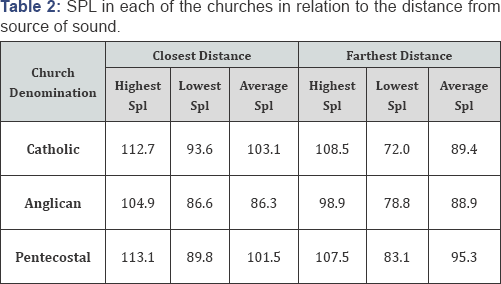
Thirty (30) churches participated in the study, with 10 each from Catholic, Anglican and Pentecostal churches. The average sound pressure levels (SPL) recorded were 96.3 ± 6.8dB (catholic), 87.6 ± 2.6dB (Anglican) and 98.4 ± 3.1 dB (Pentecostal). This is as shown in Table 2. The highest SPL recorded was 113.1dB, in Pentecostal churches (closest to the speakers); while the lowest SPL recorded was 72.0dB, in catholic churches (farthest from the Table 3: Average SPL in the churches. speakers). The average SPL recorded in sitting position closest to the speaker was “highest” in Catholic church (103.1dB), while the average SPL recorded farthest from the source of sound was “highest” in Pentecostal churches (95.3dB). These are as shown in Table 3. The sound density was highest in Anglican churches (69.3dB/m x 10' ), and the least was Pentecostal (19.9 dB/m2 x 10'3). As shown in Tables 4 & 5 below.
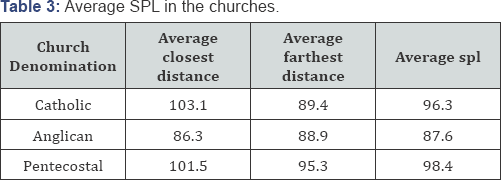
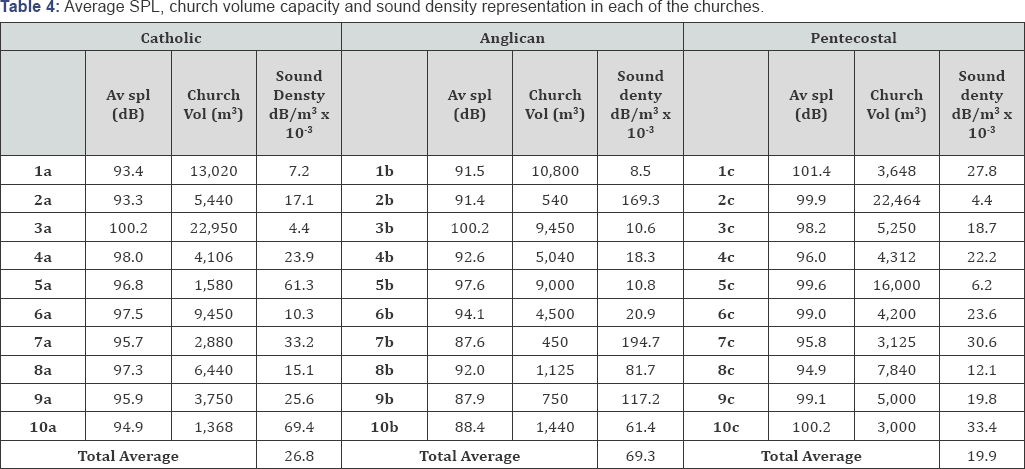
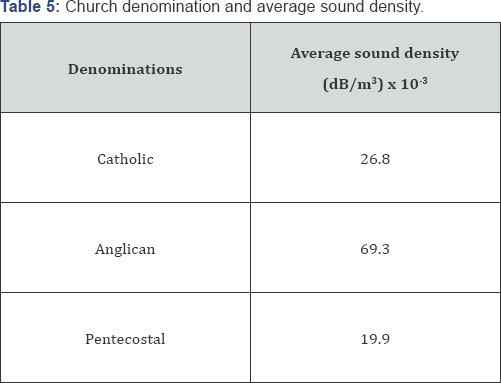
The duration of church services/mass was between 2-7 hours with a mean of 3.03 hours. The mean duration in Catholic Church was 2 hours, while in Anglican and Pentecostals were 3.0 and 4.1 hours respectively. This is as shown in Table 6 below. All Catholic Church buildings were purpose built, while 5 (50 %) of the Anglican and 6 (60%) of the Pentecostal churches studied were purpose built. This is as shown in (Figure 1). The highest church volume (22950m3) was in the Catholic Church, while the Anglican Church had the least (450m3). This is as shown in (Figure 2). The Pentecostal churches had the highest estimated population, followed by Catholic and the least is the Anglican Church. This is shown in (Figure 3). Most of the churches have bands, choir, Preachers, Organ or Piano. The number of speakers in catholic churches were between 6-14, while in Anglican were 6-12 and Pentecostal, 9-30. All the speakers in the catholic churches were at all levels (floor, ear, and high), while the Anglican and Pentecostal churches had speakers predominantly at the ear and floor level. All SPL recordings were all done during the daytime.
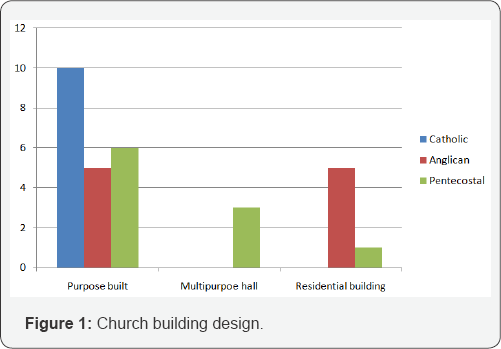
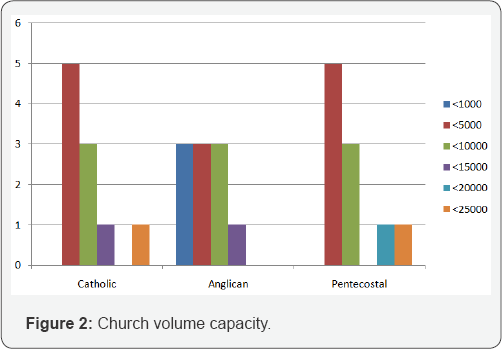
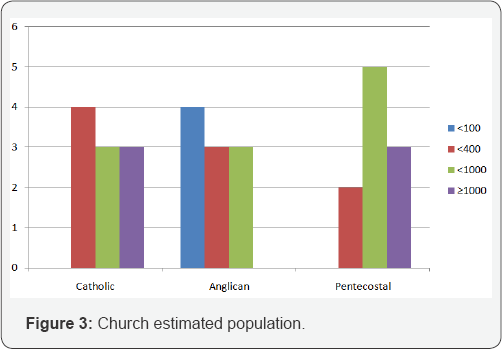

Discussion
Nigeria is a country with the highest number of churches in a capital city, with the highest religious proliferation in the world [9,10]. Church worshippers and their religious leaders are exposed to health hazards during church services/mass due to exposure to high sound levels [15]. These levels of sound carry sound energy able to produce noise induced hearing loss [15]. In this study, the highest sound pressure level (SPL) was recorded in Pentecostal (98.4 ± 3.1 dB), followed by catholic (96.3 ± 6.8dB) and the least was in Anglican churches (87.6 ± 2.6dB). The average SPL (103.1dB) recorded was “highest” in sitting positions closest to the speakers in Catholic churches. These values are not far from what was recorded in the Anglican and Pentecostal churches. The average SPL recorded farthest fromthe sources of sound was “highest” in the Pentecostal churches (95.3dB). These SPL are far from the normal healthy ambient noise level (50-60dB) and higher than the maximum permissible limit of 75 dB recommended by the National noise regulatory Agency in commercial and residential areas [13].
This finding is similar to what was reported among Protestant churches in Brazil, where the average noise exposure exceeded 85 dB in a four-worship analysis [15]. This shows that the sound exposure levels in the churches are very high and are comparable to the SPL found in the music studios; industrial environments like the Oil rigs, mechanical and metallurgical industries; and high noise recreational environments [6,15]. This makes an unquestionable statement in the similarities between the two environments. Thus, considering the risks of sound exposure, a hearing conservative/preventive program must be ensued in all our churches.
The risk of sound exposure is increased with increasing duration of exposure [16,17]. The duration of church services/ mass in this study is between 2-7 hours in all the churches, with the mean duration highest in the Pentecostal churches (4.1 hours), followed by Anglican (3 hours) and catholic (2 hours) churches. When comparing the average SPL and the mean duration of the church services as shown in the (Table 7) above, gives a threshold higher than the recommended daily permissible noise level exposure in the prevention of hazardous effects of sound as shown in (Table 1).

Most of the churches have different categories of sources of sounds, including the bands, choir, organ or piano and during preaching. The bands, organ or piano amplifies the sound which increases the intensity. The same amplification also happens during preaching and from the choir by the microphone. This also increases the sound energy and exposure risk. The sound emanating from the sources of sound are further amplified by the loud speakers. The higher the number of sound speaker the higher the sound energy generated. The numbers of speakers in each of the churches in this study ranges from 6-30, with the Pentecostal churches having the highest (9-30). This shows a higher attendant risk of exposure in the Pentecostal churches compared to the other denominations.
Speaker position is very critical when assessing the level of sound an individual is exposed to at ear level, the sound level an individual is exposed to is highest when compared to the floor or at higher levels. The churches in this research all have speakers at all levels (floor, ear and high), making it higher in propensity to cause deleterious effect. The volume capacity of the places of worship may be indicative of the value of reverberation time and it is important in the aspect of propagation of sound in an enclosed space [15]. Although, there is not a significant correlation between capacity and SPL, but it is important in assessing the sound density which correlates the amount of sound energy within the church volume space [15].
However, church volume capacity is very important when considering the reflective surfaces in the churches. Ideally, a purpose-built church put into account the acoustics during the building planning [12]. An acoustic building considers both the early and late reflection of sounds which is generated from the sources, while confused sounds emanate from buildings not acoustically planned which causes greater exposure risk [12]. This research noted that all the catholic churches studied and about 50-60% of the Anglican and Pentecostal were purpose- built but none was acoustically designed. This shows that there is a higher tendency in producing confused sounds which are of a higher sound exposure risk in all the churches. This study also noted a very large congregation in our churches, with the highest reported in the Pentecostal churches, followed by the catholic and Anglican. The possible presence of children among the worshippers also requires attention and caution, because they show greater susceptibility to loud sounds [18]. This means that a large population is being exposed to sound hazards during church worships hence, re-enforces the need to introduce or commence a sound preventive program in our churches.
Recommendation
a) The sound speakers should be positioned high and not too close to the worshippers to reduce the effect on the ear.
b) Sound limiters should be attached to sound devices in the churches to reduce intensity.
c) Churches should be acoustically designed to reduce the resultant sound energy produced.
d) There should be regular public enlightenment on the hazards of sound exposure and the requirements of the Noise regulatory Acts.
e) The church leaders should be educated on the importance of regulating the sounds generated within the church.
f) Implementation or enforcement of the Nigerian National environmental standard and regulation Act to ensure compliance.
Conclusion
A high sound pressure level was reported in all the churches above the safety permissible limits of sound.
All the churches had long sound exposure time with the Pentecostal churches being the highest. Significantly, all the church buildings were not acoustically designed which increases the deleterious effect of the sound.
References
- World health organization. Occupational noise: assessing the burden of disease from work related hearing impairment at national and levels. (2014).
- Bredberg G (19685) Cellular pattern and nerve supply of the human organ of Corti. Acta Otolaryngol (Suppl 236): 1-135.
- World health organization (1997) Prevention of noise induced hearing loss. A report of an informal consultation. Geneva: world health organization pp. 1-55.
- Hong O, Kerr MJ, Poling GL, Dhar S (2013) understanding and preventing noise induced hearing loss. Dis Mon 59(4): 110-118.
- Foster JR, Hall DA, Summerfield AQ, Palmer AR, Bowtell RW (2000) Sound level measurement and calculations of safe noise dosage during Epi at 3T. Journal of Magnetic Resonance Imaging 12(1): 157-63.
- World health organization. (2015) A review on hearing loss due to recreational exposure to loud sound. Geneva: world health organization 2015: 7-8.
- Bethesda MD (2014) Noise induced hearing loss. National institute on deafness and other communication disorders.
- National institute of occupation safety and health (1988) Self reported hearing loss among workers potentially exposed to industrial noise in the USA. Journal of American Medical Association 259(15): 22132217.
- Akintaro OA (2014) Perceived effects of noise generated by religious houses on the health of the people of osun state, Nigeria. Journal of education and practice 5(19): 91-95.
- Adesanya IO (2011) Environmental effect of churches proliferation: the redeemed Christian church of God as a case study. International journal of humanities and social sciences 1(15):177-182.
- Richard R Hammar (2005) Sound Advice: is your worship too loud? Church law and tax report.
- Quarteri J, Ambrosio SD, Guarnaccia C, Iannone G (2009) Experiments in room acoustics: modeling of a church sound field and reverberation time measurement. WSEAS Transactions on Signal Processing p. 1-10.
- Federal Republic of Nigeria official Gazette (2007) National environmental noise standard and regulations enforcement agency Act 2007. Abuja: Federal Republic of Nigeria official Gazette 96 (67): 1-21.
- National Institute for Occupational Safety and Health (NIOSH) (2013) Evaluation of Smart Phone sound measurement applications: Engineering research report, Department of Health and Human Services. NIOSH p. 1-37.
- Luiz FS, Rogerio C (2011) Noise exposure levels of priests and worshippers in protestant churches. International journal of occupational safety and ergonomics 17(1): 79-86.
- Fletcher H, Munson WA (1933) Loudness, its definition, measurement, and calculation. Journal of the Acoustical Society of America. 5: 82-108.
- Suter A (1991) Noise and Its Effects, Administrative Conference of the United States.
- Berglund B, Lindvall T (1995) Community noise. Stockholm, Sweden: World Health Organization 2(1): 1-195.





























